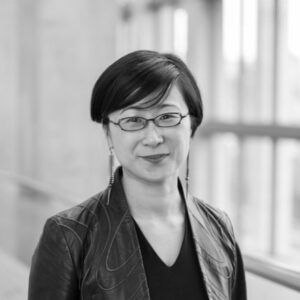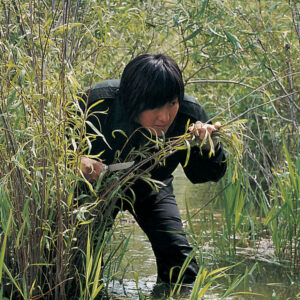Mul Maeum 2022

Jin-me Yoon, Mul Maeum (video still), 2022
Three-channel video, 30:48
Mul Maeum, meaning water-heart-mind, is a three-channel video and photographic series that reimagines human and planetary connectivities by weaving together three Korean sites through the flow of water. Linking these sites through visual and sonic waterscapes as well as through the work’s circular structure, Jin-me Yoon creates a poetics of migration, inspired by Édouard Glissant’s Poetics of Relation, that emphasizes flow and entanglement in both human and non-human worlds, as opposed to categorization, separation, progress, and control.

The film begins on touristic Jeju Island, South Korea, with a story of new beginnings and radical hospitality—the journey of a family of Yemini refugees who found protection there in 2018, prompting discussions in Korea about identity and belonging. As we hear the fragile adolescent voice of the daughter, Fatima, singing, we see her family digging a hole on the beach, an action performed by Yoon’s own family in Long View, 2017. This simple act of digging a hole seems at once playful and profound, functioning in this work as a metaphor for digging new roots, setting in motion new life. The refugees are welcomed by a Jeju woman who, as she dances, is transformed into jewel-toned orbs that pulse with joy and movement, cinematically suggesting the possibility of new forms of radical openness and togetherness.

This sense of precarious possibility is followed by loss, as the work transitions from a poetics of migration in the human world to the degradation of mobility and environment in the non-human world. Plunging the viewer underwater, the camera resurfaces at Saemangeum Seawall, the longest dyke in the world, which has left the East Asian–Australasian Flyway parched and disrupts the migration of 330,000 birds every year. The landscape is empty, dry, littered with abandoned boats and haunted by mysterious wooden Jangseung poles, carved by activists in protest of the seawall. As opposed to the lush cinematography of the sections on Jeju, the sections on Saemangeum are executed using choppy hand-held camera movements and images mostly drained of colour, which are set against the sound of airplanes and military exercises from the air base that has been built on the former estuary. Melancholic and raw, these segments capture the environmental costs of industrialization, militarism, and unrelenting progress.

Air raid sirens and images of searchlights cut in to bring the third site into the work: the Demilitarized Zone (DMZ) between North and South Korea. This four-kilometre-wide zone along the ceasefire line of 1953 is ironically the most biodiverse region in both Koreas, providing refuge to six thousand species of flora and fauna that pass freely across the world’s most militarized border. Over the outline of binoculars, used by tourists on the South Korean side of the border to observe the North Korean side, Yoon presents a pedestrian view of the North Korean “Other” farming, walking, and biking, as well as moving images of birds walking, flying, and murmurating. This pastoral image gives way to black and white archival footage of Koreans migrating during the Korean War, which Yoon then layers with film of migrating birds, surfers in the water, and parachutes that resemble jellyfish. These contrasting images of forced migration and closed borders juxtaposed against ethereal visions of freedom of movement in the human and animal worlds resonate poignantly, again questioning the consequences of modernization.

The film ends with a return to Saemangeum, with footage of construction on the estuary and an aggressive vertical pan of the monument that was built to the sea wall. The sound of jets taking off reminds us of the nearby Gunsan air force base. Once the camera shoots up the side of the monument, viewers are confronted with a split screen, which creates a silent memorial in place of the monument for what has been lost in the anthropocentric drive for progress. Mul Maeum then loops, returning to a horizontal camera angle, taking us back to the remaining migrating birds in the estuary, the water suggesting the interconnectedness of our planetary ecosystems and our lives.


 About the Author
About the Author
 More Online Art Books
More Online Art Books
 Acknowledgements
Acknowledgements